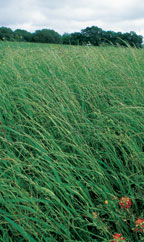Human Flower Project
Thursday, March 24, 2005
Wildflower Watchdogs
Two stories—from the United Kingdom and the state of Texas—say that wildflowers are fast disappearing.
After heavy rains in the U.S., most wildflower stories this spring are punctuated with exclamation points of glee. But those who take a longer view of things aren’t happy with what they see.
Plantlife, a conservation group in England, has found that each county in the U.K. is losing “up to 10 species of wildflowers every ten years.” Bluebells, anemones, and foxgloves are all “in retreat,” the eco-group has found, after reviewing reports from over 3000 volunteers and plant experts.
Botanists in England attribute the wildflower decline to “pollution from cars, fertilisers, and human sewage in water.” Widespread use of fertilizers particularly has enriched the soil so that “common plants” (the English don’t seem to use the word “weed”) like cleavers, hawthorn and stinging nettle crowd out rarer wildflowers. At the end of its five-year study, Plantlife found that wildlife depletion was happening much faster than botanists had expected.
 Stephan Myers photographed the same spot in 1988 and 2001, showing how ryegrass had overtaken a wildflower field in Texas.
Stephan Myers photographed the same spot in 1988 and 2001, showing how ryegrass had overtaken a wildflower field in Texas.
Along much the same lines, longtime observers in Texas see the extent and variation of spring wildflowers declining. Stephan Myers’ excellent article for Texas Co-Op Power in March 2003 offers strong evidence that ryegrass planted by the state highway department has overshadowed the wildflowers. Ryegrass, planted as a cover crop, also produces toxins “that efficiently kill neighboring plant competitors.”
As John Thomas, owner of Wildseed Farms in Fredericksburg, TX told Myers, “Spring wildflowers are one of the most important natural events we have in Texas….(a) celebratory rite of spring.” Just now, slopes along the interstate and Central Texas fields are beginning to bubble up with Indian paint brush, bluebonnets, prickly poppy, and primrose.

According to veterinarian and naturalist Bill Eikenhorst, “Wildflowers do best in disturbed and marginal soils. But with the decline of …farming and ranching industries, we no longer have broad areas of distressed soil needed for good wildflower populations.”
Not enough ranching, too much fertilizer, too few cattle, too many cars—the wildflowers’ demise is an unintended consequence of a million Average Joes and Joans. It’s going to take a major human flower project to conserve the bluebell and the Indian paintbrush. In seedsman Thomas’ words, ““Wildflower population declines are a man-made problem and only man (sic) can fix it.”




